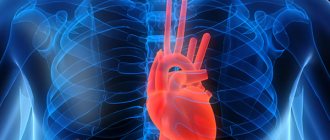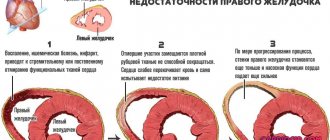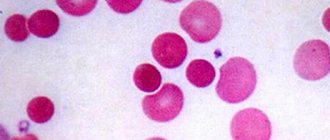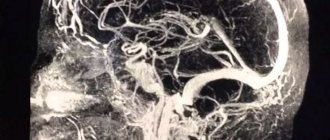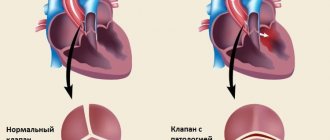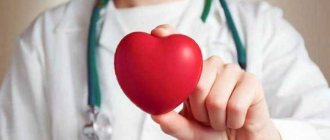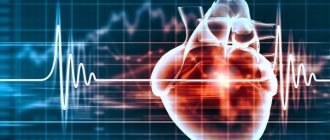Echocardiography with Doppler analysis is a diagnostic research method that is based on the reflection (echo) of ultrasound waves from the heart. With its help you can find out what condition the individual elements and valve apparatus are in. Echocardiography is often used to detect heart disease. The need to use this research method is determined by the doctor.
The essence of the technique and what it shows
As already mentioned, cardiac ECHO is a modification of standard ultrasound of internal organs. However, unlike other methods that are similar in meaning, the cardiography apparatus can operate in several modes.
For example, duplex scanning is available to a diagnostician. Doppler ultrasound is used, among other things, to examine the speed of blood flow. Its quality. This is important when diagnosing, for example, ischemic disease, assessing the condition of an organ after a heart attack.
Like other ultrasounds, echocardiography is completely safe.
What does ECHO show as part of a routine examination:
- Mass, the amount of muscle tissue in the area of the left ventricle of the heart. As a rule, it changes with a prolonged increase in pressure. Untreated hypertension is especially dangerous.
- An echogram of the heart will show the intensity of blood movement through the pulmonary artery. This vessel is one of the largest. Any violation is fraught with immediate complications. Up to and including death. Especially the increase in local pressure.
- Stroke volume. The amount of blood that the heart throws into the aorta and “drives” in a large circle. Many defects change these indicators, so deviations are quite informative.
- Condition of the left atrium.
- Wall thickness.
- Echocardiography of the heart shows even the slightest changes in cardiac structures: the position of the myocardium, heart valves (tricuspid, mitral, etc.) at the moment of contraction and return to a calm state. This indicator is defined as end systolic and diastolic volumes.
- General position of the heart. Its dimensions, anatomical location. Including regarding other organs of the chest.
The technique shows the morphological features of cardiac structures.
What does cardiac echocardiography reveal?
When conducting an echocardiographic examination, the specialist receives real-time visualization of the heart and blood vessels.
During such a scan, he evaluates the following parameters:
- the size of the heart chambers and the pressure in them;
- the presence or absence of changes in the myocardium;
- heart wall thickness;
- functionality of heart valves;
- condition of the large vessels of the heart;
- speed and direction of intracardiac blood flow.
In addition, this method measures the pressure in the pulmonary artery and determines the activity of the heart during its contraction.
What diseases can be detected
Based on the results of echocardiography, specialists make several diagnoses.
Arterial hypertension
This process can be identified indirectly. We are talking about a stable and regular increase in pressure in the vascular bed. If we talk about a full diagnosis, the condition should be called hypertension.
The long course of the pathological process leads to organic changes in the heart - the left ventricle is transformed. The muscle layer at the level of this chamber becomes thicker.
Read more about left ventricular hypertrophy in this article.
This is a kind of compensatory mechanism. This way, the cardiac structures can pump blood with greater force. The intensity of each blow increases. This is not normal, but an understandable phenomenon.
The longer the pathology exists, the worse the situation becomes. Possible cardiomegaly. Excessive growth of a muscular organ. Then they will not be able to perform their functions.
Heart defects
Both congenital and acquired. Mainly those that affect the valves - aortic, mitral, tricuspid, less often the septum between the chambers.
Such conditions are extremely dangerous. Because without treatment early on they lead to generalized dysfunction and circulatory disorders. And this is a direct path to death from heart failure or heart attack. Therefore, immediately after detection, the issue of treatment is decided.
Some congenital anomalies are classified as defects very conditionally. For example, an open oval window. In this case, they usually do nothing. They simply observe the patient from time to time, every year.
Thromboembolism
Dangerous disorder. Its essence is the blockage of large vessels with blood clots. A cardiac echo is a method that allows you to see blood clots in the pulmonary artery and coronary vessels. Thanks to this, you can receive treatment in a timely manner. The patient will remain alive.
Read more about the types of thromboembolism here; blockage of the pulmonary artery, possible risks and treatment methods are described here.
IHD in the form of angina pectoris
Classic situation: disturbance of trophism (nutrition) of the heart and its tissues. Accompanied by severe chest pain, shortness of breath, nausea and other symptoms. It's not a heart attack yet, but it's not that far off. One step left.
Unstable angina is especially dangerous. It proceeds unpredictably, so no one can say in advance how the process will end during the next attack.
An echocardiogram gives a picture in which areas of dystrophy are clearly visible, and areas where blood flow is impaired will be detected by echocardiography with Doppler analysis.
Symptoms of an angina attack and methods for correcting the condition are described in this article.
Actually a heart attack
Emergency condition. When it happens to a patient, there is little time for diagnosis. Usually the fact is stated after the initial treatment measures.
The chances of recovery depend on how quickly therapy is started. Through ECHO Kg, a focus of necrosis (death of cardiac structures) is noticeable. The smaller it is, the easier the treatment will be.
Heart sclerosis
Consequence of heart attack, inflammatory processes in cardiac structures. This is a condition in which certain areas of the myocardium become scarred.
Connective tissue of this kind is unable to contract or stretch. Therefore, part of the organ falls out of work.
The condition is dangerous because it provokes further worsening of dystrophy and problems with the nutrition of the heart. Lifelong treatment is required. Echocardiography shows both the focus of cardisclerosis itself and the degree of impairment.
Tumors
Neoplastic processes in a muscle organ, oddly enough, are quite rare. However, they pose a huge danger.
There are two reasons:
- The first is that even benign formations (for example, myxoma), having reached a size of more than 1 cm, compress and squeeze the heart. Hence the violation of the shape of the organ, dysfunction, and insufficient nutrition.
- Secondly, if the tumor is malignant, it grows through the muscle tissue. Which means it destroys them. Compression is also present, the harm is double.
Treatment is urgent, surgical.
Pericarditis
Inflammatory process. Provocateur - pyogenic flora and other agents. As a rule, streptococci or staphylococci are to blame. Rarely seen.
A special case is the accumulation of fluid in the pericardium - hydropericardium. If the pericardial sac fills with effusion and blood, local pressure increases. As soon as the indicator becomes equal to that inside the chambers of the muscular organ, cardiac arrest occurs. Therefore, the condition is classified as urgent.
Myocarditis
Inflammatory disease of the heart itself. Accompanied by severe pain. When scanning, foci of changes are noticeable. If not treated in time, consequences will occur like a heart attack. Perhaps even harder.
Cardiomyopathy
A typical pathological process for those who engage in intense physical labor. For example, for athletes. Alcoholics and heavy smokers are at increased risk.
The essence of the process is a change in the myocardium: the muscle layer grows, becomes excessively large, or stretches.
This is not normal and requires therapy. As a rule, medicinal. Plus lifestyle corrections.
Read more about the types of cardimopathy and treatment methods in this article.
Rhythm disturbance
Various. From atrial fibrillation to paroxysmal tachycardia. Echocardiography alone is unlikely to help here. To identify functional disorders, an ECG will also be required.
Changes in the anatomical position of the heart
For example, mirror (dextrocardia). It can be a defect or a natural and completely normal phenomenon.
Approximately such diagnoses can be made or confirmed based on the results of echography. In addition, other examinations are also needed. ECG, stress tests, bicycle ergometry, monitoring, etc.
Answers to frequently asked questions
- What is the difference between cardiac ultrasound and Echo-CG? Answer: Echo-CG stands for echocardiogram; this method of ultrasound includes elements of electrocardiography (ECG). During the examination, ultrasound and ECG are performed simultaneously, which increases the information content of the diagnosis.
- How much does a heart ultrasound cost? Price on average from 1,400 rubles. up to 3,000 rub. The cost depends on the region, the most expensive in Moscow and St. Petersburg.
- Which is better, ultrasound of the heart or ECG, what is the difference? Electrocardiography (ECG) – results are assessed using an electrocardiogram. Echocardiography is a modern diagnostic method; the organ is visualized on an ultrasound machine monitor, and is also combined with an electrocardiogram. Of course, the ultrasound method looks better here, but perhaps it is enough for a person to do an ECG; it is better to leave the choice to the doctor.
The importance of echocardiographic examination in the diagnosis of cardiac diseases cannot be overestimated. Its safety, information content and accessibility have made ultrasound very popular.
(Be the first to rate this article!)
Indications and contraindications
Since the technique is universal, there are quite a lot of reasons for ECHO CG.
- Chest pain of unknown origin. The patient is not always right in assessing his well-being. Discomfort occurs with stomach diseases, intercostal neuralgia and other conditions. The pain is successfully masked. But it is necessary to check the position of the muscle organ.
Read about how to understand that it is the heart that hurts and distinguish heart pain from others.
- Systematic increase in blood pressure. Hypertension does not happen out of the blue. Secondary forms are caused by kidney disease and hormonal dysfunction. And the primary ones develop in pathologies of cardiac structures. Therefore, you need to check the culprit using an ultrasound technique.
- Heart rhythm disturbances. Using the ultrasound method, organic changes can be detected. Doctors do not always receive information. Therefore, echocardiography is supplemented with an ECG, often also with 24-hour Holter monitoring. When an automatic device reads blood pressure and contraction frequency of a muscle organ throughout the day.
- Visible symptoms of possible heart disease. For example, cyanosis of the nasolabial triangle. Paleness of fingers, etc. Including shortness of breath. That is, those manifestations that usually indicate pathologies of a muscular organ. In this case, the technique is used as a preventive measure.
- Suspicion of a tumor. Indirectly, the same symptoms as above indicate a neoplastic process. Shortness of breath, weakness, blue discoloration of the area around the mouth, pallor, rhythm disturbances. Ultrasound gives a rough idea of neoplasia. The exact same result can be obtained through MRI.
- Exercise intolerance. Decreased tolerance. Accompanies angina pectoris and ischemic disease. An ultrasound is mandatory.
- Treatment being carried out. In this case, echocardiography is used to identify possible complications and side effects of therapy. Also as part of a preventive examination.
- Already established cardiological diagnoses. To identify deterioration (to study the dynamics of the disorder).
- Evaluation of treatment effectiveness. Including surgical.
Why is echocardiography performed?
EchoCG is used to identify changes in the structure of cardiac muscle tissue, dystrophic processes, malformations and diseases of this organ.
A similar study is carried out on pregnant women if there is a suspicion of pathology of fetal development, signs of developmental delay, the presence of epilepsy, diabetes mellitus, or endocrine disorders in the woman.
Indications for echocardiography may include symptoms of heart defects, suspected myocardial infarction, aortic aneurysm, inflammatory diseases, neoplasms of any etiology.
The study should be carried out if there are varicose veins and thrombophlebitis to exclude the danger of thromboembolism.
An ultrasound of the heart must be performed if the following symptoms are observed:
- chest pain;
- weakness during physical activity and regardless of it;
- cardiopalmus:
- interruptions in heart rhythm;
- swelling of the arms and legs;
- complications after influenza, ARVI, sore throat, rheumatism;
- arterial hypertension.
The examination can be done at the direction of a cardiologist or at your own request. There are no contraindications to its implementation . There is no special preparation for a cardiac ultrasound; it is enough to calm down and try to maintain a balanced state.
During the study, the specialist
- the state of the myocardium in the phase of systole and diastole (contraction and relaxation);
- the size of the heart chambers, their structure and wall thickness;
- the condition of the pericardium and the presence of exudate in the cardiac sac;
- functioning and structure of arterial and venous valves;
- the presence of blood clots, neoplasms;
- the presence of consequences of infectious diseases, inflammation, heart murmurs.
The results are most often processed using a computer program.
More details about this research methodology are described in this video:
Who is the study contraindicated for?
Contraindications are minimal, but they still exist.
- Lung diseases. Because patients with respiratory failure find it difficult to lie still for 10-20 minutes.
- Deformation of the sternum. For example, a hump. In this case, there will be problems with visualizing heart tissue.
- Inflammatory processes of the skin of the breast.
- Mental disorders. Excluding adequacy. For example, exacerbation of schizophrenia.
Contraindications are not absolute. Doctors are considering options to perform the procedure.
Types of Echo CG and their differences
There are several types of cardiac ultrasound. Basically, methods are divided according to the method of access to the muscle organ.
- Classic or transthoracic form, through the anterior wall of the sternum. This is the most common option. Gold standard for primary diagnosis. The ultrasound sensor is placed on the chest, after which the doctor changes its position. To visualize tissues in different projections and from several angles.
- The second option is an ECHO study with contrast enhancement. In essence, it’s the same transthoracic ultrasound. But this time special substances are injected intravenously. They accumulate in blood vessels, tissues and enhance the reflection of ultrasonic waves. Makes the picture clearer. In general, the method differs little from the previous one. From a technical point of view, everything is the same. But with contrast you can get much more information.
- Finally, transesophageal echocardiography. Invasive research. Due to its high complexity, it is performed only in a hospital setting. Moreover, problems and unforeseen disorders are possible afterwards. It is considered a particularly accurate method compared to others. The technique is used if previous modifications have not produced results.
Another way of classification is by the nature of the study.
- ECHO at rest. Occurs especially often. This is a typical cardiography.
- Assessment of cardiac condition after exercise. Appointed in controversial situations.
Contraindications for echocardiography
In general, echocardiological examination is a completely harmless procedure.
However, due to some anatomical features of patients (deformation of the chest, quite pronounced hair on the male chest, obesity, inflammatory skin lesions in the heart area, large size of the mammary glands of women), difficulties may arise in the sufficient penetration of ultrasound through transthoracic echocardiography.
Meanwhile, patients who have been diagnosed with a stomach ulcer or acute gastritis, or those who suffer from tumors of any severity, should not undergo cardiac ultrasound by inserting a probe through the esophagus.
Preparation
No special events needed. Conventionally, we can name the following requirements:
- The day before the test you should not smoke. Otherwise, the vessels will narrow and the doctor will detect false changes. In the coronary and pulmonary arteries.
- The same goes for alcohol. You should give up alcohol a few days in advance. To make the results more accurate.
- On the day of the procedure, you should not engage in intense physical activity. You need to follow a gentle regime. Peace is desirable.
- You must arrive at the appointed time. It is recommended to take a towel or disposable napkins with you. To remove excess gel after echocardiography.
Otherwise, no preparation is needed. You can do everyday, familiar things.
How to prepare for research
Transthoracic ultrasound, like other echo methods, does not require special preparation. You should limit your intake of substances that affect cardiac activity. This is especially true for echocardiography with dopplerography. If the subject is taking any medications, the doctor must be notified about this. Otherwise, the results may be incorrect.
Separately, it is necessary to mention transesophageal echocardiography. During the procedure, a sensor is inserted into the esophagus, through the wall of which the heart is visualized. In this case, you should refuse food and liquid 5 hours before the test.
Progress of the study
The patient goes to the office of a functional diagnostics specialist. Next, the procedure is carried out according to the usual scenario for many, like a regular ultrasound.
- You need to lie down on the couch.
- The doctor will lubricate the chest with a special gel. It conducts ultrasonic waves better, so the picture will be more accurate.
- The specialist places a sensor and begins to study the anatomical area.
- During the procedure, the doctor changes the position of the scanner and examines the organ from different angles. Works in several modes. Do not be afraid of the strange sounds that the device makes. This is fine.
- During the scan, the specialist may ask you to hold your breath. Roll over on your side. The patient's job is to follow the doctor's instructions. After the procedure is completed, you can go home.
Other modifications differ. If a contrast study is prescribed, a standard ultrasound is first performed, then contrast is administered and the procedure is repeated. Everything takes about 10-20 minutes. Plus or minus. Transesophageal ultrasound of the heart requires more time.
The echocardiogram is given to the patient after another 10-20 minutes. Because a specialist must give an opinion. Sometimes a person receives only a diagnostic protocol, without the doctor’s explanation.
Echocardiography method
When performing an echocardiographic examination, two techniques can be used: transthoracic and transesophageal.
Each of them differs in the method of implementation and the degree of execution.
Transthoracic echocardiography
This type of ultrasound is considered the oldest and therefore the most common. The transthoracic technique for detecting heart diseases is carried out through the chest using an ultrasound probe pressed against the patient's body in the area of the heart.
The echocardiograph displays the results of the signals, which are converted into multiple images of the heart. Typically, the person undergoing this examination is on a couch in a supine or lateral position.
Transesophageal echocardiography of the heart
Despite the great popularity of the transthoracic echocardiography technique, some cases of patient examination require a more thorough approach.
Meanwhile, the transesophageal technique, despite the technical difficulties of its implementation, makes it possible to: more accurately examine the heart for the presence of tumors and blood clots, promptly identify pathologies of prosthetic valves, detect congenital defects, etc.
Decoding the results
The interpretation is carried out by the treating specialist. Cardiologist. Understanding what's what on your own is extremely difficult. Special medical knowledge is required. To an inexperienced person, the conclusion and protocol will seem like Chinese writing.
Attention:
The results need to be deciphered in a system and not individually. Cardiography alone is not enough to draw far-reaching conclusions. Although there are exceptions.
Normal indicators for an adult are presented in the tables:
Left ventricle and atrium
| Index | Men | Women |
| Myocardial mass | 85-220 g | 65-160 g |
| Volume at rest | 165-195 ml | 60-135 ml |
| Size during diastole | 35-55 mm | |
| Size during systole | 25-35 mm | |
| Left atrium size | 25-35 mm | |
| Ejection fraction | 55-70% | |
| Shortening fraction | 25-40% | |
| Rear wall thickness at rest | 8-11 mm | |
| Interventricular septal thickness at rest | 8-10 mm | |
Right ventricle and atrium
| Index | Meaning |
| Relaxed size | 75-110 mm |
| Pancreas wall thickness | 2-5 mm |
| Right atrium size | 25-45 mm |
| Right ventricle size | 20-30 mm |
| Thickness of the interventricular septum at systole | 10-15 mm |
| Thickness of the interventricular septum at diastole | 6-11 mm |
Blood flow speed
| Name | Index |
| Transmitral | 0.5 – 1.5 ms |
| Transtricuspid | 0.3 – 0.7 ms |
| Transpulmonary | 0.6 – 0.9 ms |
| Transaortic | 1 – 1.7 ms |
Other
| Index | Meaning |
| Normal fluid level in the pericardium | 10-30 ml |
| Aortic root diameter | 20-35 mm |
| Amplitude of opening of the aortic valve leaflets | 15-25 mm |
Pros and cons of the diagnostic technique
There are many advantages of the study:
- Simplicity. An ECHO device is available in almost any district clinic. Even in the regions, not to mention the capital and large cities.
- Safety. The technique does not create harmful radiation exposure. The study can be carried out as often as the clinical case requires.
- High scanning speed. Everything takes about 10-20 minutes. Plus or minus.
- Information content. Despite the accessibility and simplicity of the technique, it is effective enough to detect most diseases.
- Non-invasive and painless. Not counting the transesophageal method. It is still classified as invasive. But, nevertheless, well tolerated. And the procedure is rarely required.
- Minimum contraindications. They are rather formal.
- Variability. Several scanning modes. For example, echocardiography with Doppler analysis is a way to study not only the heart itself, but also the vessels of the local circulatory network.
There is only one minus - ECHO CG does not provide accurate information in many cases. It is necessary to appoint auxiliary measures. Can this be called a negative trait? Hardly. Because the method copes with its tasks one hundred percent.
ECHO of the heart shows the condition of the myocardium, the entire organ and the local circulatory network. The initial parts of the aorta, pulmonary artery. This is a universal, safe and effective diagnostic technique.
Cost of the procedure
- Few government institutions have special equipment to conduct EchoCS examinations. Those who have the appropriate material and technical base (state cardiac dispensaries) carry out the procedure according to the directions of the local cardiologist at the place of residence. In this case, the procedure can have a minimal cost (up to 300 rubles) or be carried out free of charge.
- In most cases, such examinations are carried out on a commercial basis in private clinics. The cost of the procedure varies from 2200 rubles to 4000 rubles. It all depends on the pricing policy of the institution itself and the availability of modern and high-precision equipment. At the same time, the cost of echocardiography in large cities is usually higher than in other localities.
Summarizing the above, we can confidently say that the EchoCS method is accurate, effective, and informative both in the initial stages and in the post-therapeutic period. The method is absolutely safe and can be performed on both newborns and adults. And the location entirely depends on the preferences and financial capabilities of the person.
The heart, as the main human organ, needs timely diagnosis and treatment, so trust only specialists.
